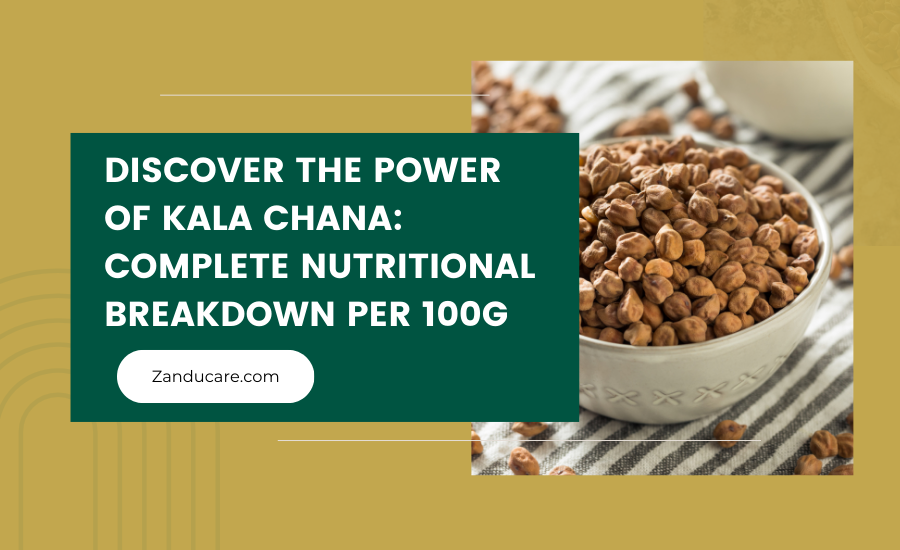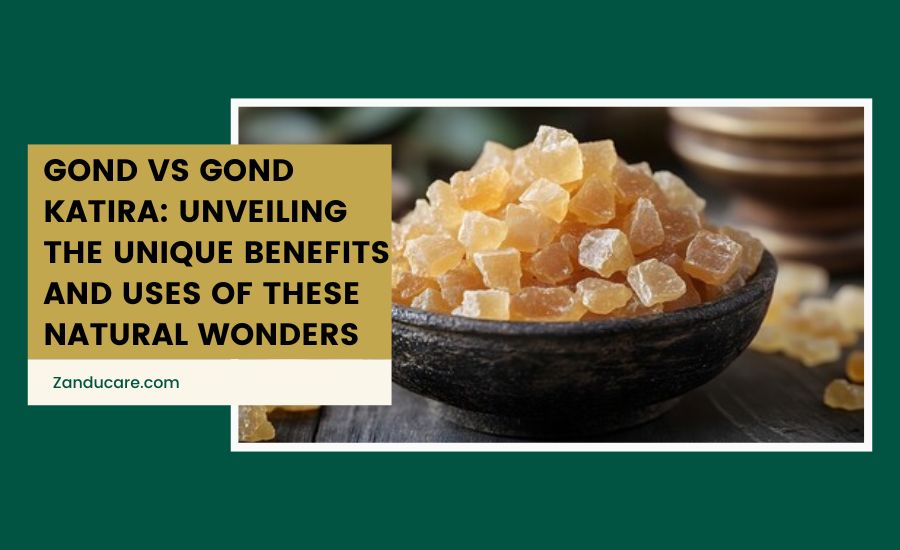
Discover the Power of Kala Chana: Complete Nutritional Breakdown per 100g
|
Key Insights
|
Kala chana, or black chickpeas, is a powerhouse of nutrients, making it a great addition to a balanced diet. When measured per 100 grams, raw kala chana offers a wide range of macronutrients, vitamins, and minerals. These nutrients help in various bodily functions and contribute to overall well-being. This simple legume packs a punch for essential nutrients our bodies need daily.
|
Did You Know?
|
Nutritional Value of Kala Chana per 100g

Here is the nutritional value of Kala Chana per 100g:
|
Nutrient |
Amount per 100g |
|
Protein |
20g |
|
Carbohydrates |
63g |
|
Dietary Fiber |
12g |
|
Fat |
6g |
|
Calcium |
57mg |
|
Iron |
4.31mg |
|
Potassium |
718mg |
|
Calories |
378 kcal |
Macronutrients in Kala Chana
Here is the overview of macronutrients in Kala Chana:
1. Protein
With 20g of protein per 100g serving, kala chana is an excellent vegetarian source of high-quality protein. The protein in kala chana contains all 9 essential amino acids that the body cannot synthesise independently. Consuming kala chana helps meet the daily protein requirements for muscle growth and development, especially for vegetarians and vegans.
2. Carbohydrates
Carbohydrates are the body's main source of energy. 100g of kala chana contains 63g of complex carbohydrates, which provide a slow and sustained release of glucose into the bloodstream. This helps maintain optimal energy levels and prevents blood sugar spikes. The carbohydrates in kala chana are digested slower, keeping you feeling fuller for longer.
3. Fat
Kala chana contains 6 g of fat per 100g serving, considered low fat. Its fats are mostly unsaturated, like linoleic and oleic acids, which are heart-healthy. The small amount of fat in kala chana helps absorb the fat-soluble vitamins A, D, E, and K.
4. Fiber
A 100g serving of kala chana provides a substantial amount of 12 g of dietary fibre. Fiber promotes healthy digestion, relieves constipation, and helps maintain bowel regularity. The insoluble fibre in kala chana helps increase stool bulk and speed up transit time in the gut. Soluble fibre helps slow digestion and nutrient absorption, regulating blood sugar levels.
5. Packed With Minerals
Black chana is equally impressive in the mineral department. It is abundant in minerals such as potassium (718-846 mg), calcium (45-57 mg), magnesium (166 mg), and iron (4.31-4.86 mg), which are essential for many body processes, such as controlling blood pressure and preserving bone health.
Health Benefits of Consuming Kala Chana

Here are some of the benefits of Kala Chana:
1. Keeps you Full for a Longer Duration
Due to its high dietary fibre content, Kala chana helps you maintain control over your diet by making you feel fuller for longer. Dietary fibers function by delaying digestion.
Additionally, the high protein content of kala chana raises hormone levels that decrease appetite. Thus, the combined action of proteins and dietary fibres reduces caloric intake in your subsequent diet.
2. Helps Manage the Weight
Kala chana is a fantastic meal option for those who wish to lose weight. Protein and dietary fibres provide a long-lasting feeling of fullness, which helps you cut back on unhealthy eating and excessive calorie consumption.
A study found that those who eat chickpeas regularly have a 53% lower chance of having a body mass index higher than 30. These individuals also have smaller waist circumferences.
3. Facilitates Blood Sugar Regulation
Black chana's complex carbohydrates break down gradually, and the soluble fibre controls how much sugar enters the bloodstream.
Chickpeas' low glycemic index of 28 reduces blood sugar levels from rising too quickly and keeps you full longer, preventing hunger cravings.
4. Decreases the Risk of Heart Disease
Kala chana contains minerals, including potassium and magnesium, that help lower blood pressure, a major risk factor for many cardiac conditions. Triglycerides and low-density lipoproteins, which are additional risk factors for heart disease, are mitigated by chickpeas' soluble fibres.
5. Prevention of Cancer
Black chickpeas or kala chana aid in the synthesis of fatty acids. Butyrate is another name for fatty acids. However, butyrate can help lower your risk of colon cancer by reducing an inflammatory process that is taking place in your colon cells.
Kala chana contains a plant chemical called saponin, which also aids in preventing the unchecked proliferation of cancer cells. Kala chana also contains vitamins and minerals that can lower the incidence of breast and lung cancer.
6. Improves Brain Health
Black chickpeas or kala chana are excellent sources of choline. One of the essential nutrients for the synthesis of chemical messengers, such as neurotransmitters, is choline.
The high magnesium level of kala chana, or black chickpeas, also aids in enhancing neuron function. Additional minerals included in kala chanas, such as zinc, magnesium, and selenium, can also aid in reducing anxiety and sadness.
7. Treats Fungal Infections
A great way to treat fungal diseases like ringworm, which can cause extreme skin itching, is to eat black chickpeas. The scalp, feet, or even the groin can have ringworm. Doctors advise consuming cooked and soaked Kala Chana daily without salt to prevent fungal infections.
8. Arrests Hair Fall
Zinc and vitamin B6, essential for healthier hair growth, are abundant in kala chana. These minerals are in charge of helping the hair follicles produce protein, which strengthens the hair.
Uses of Black Chana
Here are some of the uses of Black Chana:
1. In Salads
Soak black chana overnight, then mix with fresh veggies and herbs for a protein-packed salad. A light dressing enhances the flavours.
2. In Curries
Black chana is featured in many Indian curries, simmered with aromatic spices, tomatoes and onions. The legumes soak up the rich flavours for a hearty, nourishing meal.
3. As Snacks
Craving a healthy snack? Roast or fry black chana and season with spices for a tasty crunch. They also make flavorful chaat snacks.
4. Black Chana Flour
Ground black chana produces besan (gram flour), a gluten-free flour used in pancakes, fritters and more. It thickens soups and imparts a nutty taste.
What are the Side Effects of Black Chana?
Like any cuisine, black chana can negatively affect certain people, particularly if you eat a lot of it. You should be aware, nevertheless, that most people do not experience these adverse effects frequently. By including chickpeas in a balanced diet and eating them in moderation, you can control them.
The following are some possible adverse effects of black chana:
- Digestive Problems: Because chickpeas are high in fibre, eating too many of them might result in gas, bloating, and stomach cramps.
- Gout or kidney stones: Purines, abundant in chickpeas, might raise the body's uric acid levels and perhaps exacerbate gout symptoms in certain people.
- Allergic Reactions: Eating chickpeas may cause allergic reactions in certain people. Some of the symptoms of these allergies are itching, swelling, hives, nausea, diarrhoea, and difficulty swallowing.
- Antinutrient Content: Chickpeas contain antinutrients such as tannins and phytic acid. These substances can attach to minerals and reduce the body's absorption of them. However, soaking, sprouting, or boiling chickpeas can lessen these effects, which are often negligible.
- Interaction with drugs: Certain chemicals found in chickpeas may cause problems when taken with certain drugs. If you are on prescription medicine, always get your doctor's approval before changing your diet.
Note: See a healthcare provider for severe or ongoing symptoms after consuming chickpeas. People with specific medical issues or allergies should avoid chickpeas completely or consume them in moderation.
Kala Chana In Ayurveda

Kala Chana is a great protein source known as Chanaka in Ayurveda and is classified as a legume (Shimbi Dhanya Varga). It should be included in your daily diet for its high nutritional content and to help avoid several illnesses, such as high cholesterol, liver enlargement, mouth ulcers, and skin disorders.
It's interesting to note that how chickpeas are cooked affects their physical characteristics. Ayurveda states that Kala Chana is superior to the white or Kabuli chana variety because it balances the vata, kapha, and pitta doshas.
While Chana effectively balances pitta and kapha doshas, it also increases Vata dosha and is recommended for people with blood-related issues and high body temperatures. According to ancient medicine, Chana is astringent to taste with Shita Virya or cold potency. It is dry in nature and easy to digest, but it causes constipation.
Comparison of Kala Chana with Other Legumes
Kala Chana vs White Chickpeas (Kabuli Chana)
Despite being members of the same legume family, kala chana and kabuli chana (white chickpeas) have somewhat different nutritional profiles. Because kala chana contains more protein and fibre, it's a better choice for developing muscle and losing weight. On the other hand, Kabuli chana is frequently used in recipes like hummus and is a little simpler to prepare. Kala chana has better nutritional density and health advantages.
Kala Chana vs Lentils
Kala chana provides more protein than lentils, but because of its harder texture, it takes longer to cook. People with sensitive stomachs can eat lentils because they are milder and easier to digest. However, because of its complex carbs, kala chana offers longer-lasting energy and is frequently a popular option for those seeking it.
Also, check our other guides:- Sattu nutritional value
- Moong sprouts nutritional value
- Soya nutritional value
- Cana dal nutritional value
- Dalia nutritional value
- Sabudana nutrients
How to Incorporate Kala Chana into Your Diet
Here are some effective ways to incorporate Kala Chana into your diet:
1. Soaking and Cooking Kala Chana
To soften its tough exterior, kala chana has to soak for at least 8 to 10 hours before cooking. This enhances its digestion and cuts down on cooking time. Kala chana can be pressure-cooked or boiled after soaking. Cumin and turmeric are frequently used when cooking to improve their flavour and digestive qualities.
2. Kala Chana Recipes for Everyday Meals
Kala chana can be incorporated into your everyday diet in several ways. It can be added to soups, curries, and salads to provide taste and nutrients. In the well-known "chana masala," kala chana is cooked with tomatoes, onions, and spices to create a filling and healthy supper. It can be roasted and eaten as a snack as a crunchy and nutritious substitute for processed foods.
Conclusion
A versatile and nutrient-dense legume, kala chana offers numerous health advantages. Its nutritional composition makes it a great option for anyone wishing to make dietary changes, from aiding in weight loss to controlling diabetes and fostering heart health. From an Ayurvedic or contemporary nutritional standpoint, kala chana has something to offer everyone.
FAQs
1. Can I eat 100g of black chana daily?
You must include black chana to control your weight and obtain vital nutrients. However, consuming too much black chana can be more detrimental. You can obtain enough nutrients from 100g of kala chana protein to last the entire day.
2. What is kala chana rich in?
Kala chana is a legume high in protein, fibre, and carbohydrates. It is a fantastic source of minerals like manganese, phosphorus, iron, and copper and vitamins like B6, C, folate, niacin, thiamin, and riboflavin.
3. How much kala chana is safe per day?
Incorporating 100 grams of chana (chickpeas) into your daily diet can be beneficial. It offers important nutrients, dietary fibre, and a healthy quantity of protein. Nonetheless, it is essential to consider your specific dietary requirements and your general diet.
4. Is black chana good for gas?
Black chana is high in fibre. Thus, those who have gas or stomachaches shouldn't eat it. Additionally, it might result in bloating and diarrhoea, particularly in young children and the elderly.
References:
- Kala chana, or black chickpeas, is a powerhouse of nutrients, making it a great addition to a balanced diet (https://www.researchgate.net)
- With 20g of protein per 100g serving, kala chana is an excellent vegetarian source of high-quality protein.(https://www.researchgate.net)
- Carbohydrates are the body's main source of energy. (https://www.researchgate.net)
- Kala chana contains 6 g of fat per 100g serving, considered low fat.(https://www.researchgate.net)





